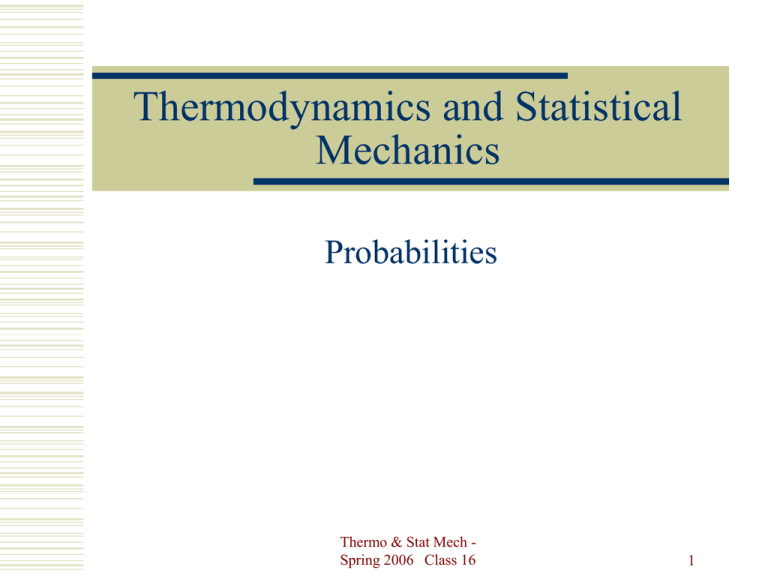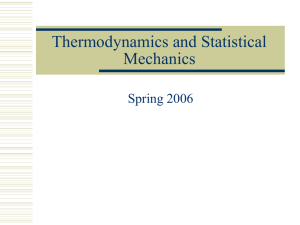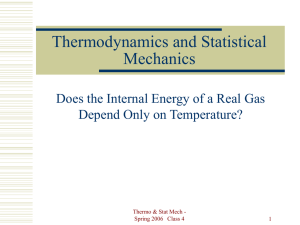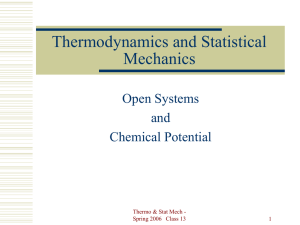Thermodynamics and Statistical Mechanics Probabilities Thermo & Stat Mech -
advertisement

Thermodynamics and Statistical Mechanics Probabilities Thermo & Stat Mech Spring 2006 Class 16 1 Pair of Dice For one die, the probability of any face coming up is the same, 1/6. Therefore, it is equally probable that any number from one to six will come up. For two dice, what is the probability that the total will come up 2, 3, 4, etc up to 12? Thermo & Stat Mech - Spring 2006 Class 16 2 Probability To calculate the probability of a particular outcome, count the number of all possible results. Then count the number that give the desired outcome. The probability of the desired outcome is equal to the number that gives the desired outcome divided by the total number of outcomes. Hence, 1/6 for one die. Thermo & Stat Mech - Spring 2006 Class 16 3 Pair of Dice List all possible outcomes (36) for a pair of dice. Total Combinations How Many 2 1+1 1 3 1+2, 2+1 2 4 1+3, 3+1, 2+2 3 5 1+4, 4+1, 2+3, 3+2 4 6 1+5, 5+1, 2+4, 4+2, 3+3 5 Thermo & Stat Mech - Spring 2006 Class 16 4 Pair of Dice Total 7 8 9 10 11 12 Combinations How Many 1+6, 6+1, 2+5, 5+2, 3+4, 4+3 6 2+6, 6+2, 3+5, 5+3, 4+4 5 3+6, 6+3, 4+5, 5+4 4 4+6, 6+4, 5+5 3 5+6, 6+5 2 6+6 1 Sum = 36 Thermo & Stat Mech - Spring 2006 Class 16 5 Probabilities for Two Dice Total 2 1 Prob. 36 % 2.8 3 2 36 5.6 4 3 36 8.3 5 4 36 11 6 5 36 14 7 6 36 17 8 5 36 14 Thermo & Stat Mech - Spring 2006 Class 16 9 10 11 12 4 3 2 1 36 36 36 36 11 8.3 5.6 2.8 6 Probabilities for Two Dice D ice Pr obability 0 .2 0 .1 5 0 .1 0 .0 5 0 2 3 4 5 6 7 8 9 10 11 12 Nu m b e r Thermo & Stat Mech - Spring 2006 Class 16 7 Microstates and Macrostates Each possible outcome is called a “microstate”. The combination of all microstates that give the same number of spots is called a “macrostate”. The macrostate that contains the most microstates is the most probable to occur. Thermo & Stat Mech - Spring 2006 Class 16 8 Combining Probabilities If a given outcome can be reached in two (or more) mutually exclusive ways whose probabilities are pA and pB, then the probability of that outcome is: pA + pB. This is the probability of having either A or B. Thermo & Stat Mech - Spring 2006 Class 16 9 Combining Probabilities If a given outcome represents the combination of two independent events, whose individual probabilities are pA and pB, then the probability of that outcome is: pA × pB. This is the probability of having both A and B. Thermo & Stat Mech - Spring 2006 Class 16 10 Example Paint two faces of a die red. When the die is thrown, what is the probability of a red face coming up? 1 1 1 p 6 6 3 Thermo & Stat Mech - Spring 2006 Class 16 11 Another Example Throw two normal dice. What is the probability of two sixes coming up? 1 1 1 p ( 2) 6 6 36 Thermo & Stat Mech - Spring 2006 Class 16 12 Complications p is the probability of success. (1/6 for one die) q is the probability of failure. (5/6 for one die) p + q = 1, or q = 1 – p When two dice are thrown, what is the probability of getting only one six? Thermo & Stat Mech - Spring 2006 Class 16 13 Complications Probability of the six on the first die and not the second is: 1 5 5 pq 6 6 36 Probability of the six on the second die and not the first is the same, so: 10 5 p (1) 2 pq 36 18 Thermo & Stat Mech - Spring 2006 Class 16 14 Simplification Probability of no sixes coming up is: 5 5 25 p (0) qq 6 6 36 The sum of all three probabilities is: p(2) + p(1) + p(0) = 1 Thermo & Stat Mech - Spring 2006 Class 16 15 Simplification p(2) + p(1) + p(0) = 1 p² + 2pq + q² =1 (p + q)² = 1 The exponent is the number of dice (or tries). Is this general? Thermo & Stat Mech - Spring 2006 Class 16 16 Three Dice (p + q)³ = 1 p³ + 3p²q + 3pq² + q³ = 1 p(3) + p(2) + p(1) + p(0) = 1 It works! It must be general! (p + q)N = 1 Thermo & Stat Mech - Spring 2006 Class 16 17 Binomial Distribution Probability of n successes in N attempts (p + q)N = 1 N! n N n P ( n) p q n!( N n)! where, q = 1 – p. Thermo & Stat Mech - Spring 2006 Class 16 18 Thermodynamic Probability The term with all the factorials in the previous equation is the number of microstates that will lead to the particular macrostate. It is called the “thermodynamic probability”, wn. N! wn n!( N n)! Thermo & Stat Mech - Spring 2006 Class 16 19 Microstates The total number of microstates is: w wn True probabilit y P(n) For a very large number of particles wmax Thermo & Stat Mech - Spring 2006 Class 16 20 Mean of Binomial Distribution n P ( n) n n where N! n N n P ( n) p q n!( N n)! Notice : p P(n) P(n)n p Thermo & Stat Mech - Spring 2006 Class 16 21 Mean of Binomial Distribution n P ( n) n p P ( n) p n n N n p P ( n) p ( p q ) p n p n pN ( p q ) N 1 pN (1) N 1 n pN Thermo & Stat Mech - Spring 2006 Class 16 22 Standard Deviation (s) n n s 2 s n n P (n)n n 2 2 2 n n n 2 n 2n n n n 2n n n 2 2 s n n 2 2 2 2 2 Thermo & Stat Mech - Spring 2006 Class 16 23 Standard Deviation 2 n P ( n) n p P ( n) n p n 2 N N 1 n p p ( p q ) p pN ( p q ) p p p 2 2 n pN ( p q ) 2 N 1 pN ( N 1)( p q ) N 2 n 2 pN 1 pN p pN q pN Thermo & Stat Mech - Spring 2006 Class 16 24 Standard Deviation s n n 2 2 2 s 2 pN q pN ( pN ) 2 s 2 Npq ( pN ) 2 ( pN ) 2 Npq s Npq Thermo & Stat Mech - Spring 2006 Class 16 25 For a Binomial Distribution n pN s Npq s q n Np Thermo & Stat Mech - Spring 2006 Class 16 26 Coins Toss 6 coins. Probability of n heads: n 6 n N! 6! 1 1 n N n P ( n) p q n!( N n)! n!(6 n)! 2 2 6! 1 P ( n) n!(6 n)! 2 6 Thermo & Stat Mech - Spring 2006 Class 16 27 For Six Coins Binomial Distribution 0.35 0.3 Probabilty 0.25 0.2 0.15 0.1 0.05 0 0 1 2 3 4 5 6 Successes Thermo & Stat Mech - Spring 2006 Class 16 28 For 100 Coins Binomial Distribution 0.09 0.08 Probabilty 0.07 0.06 0.05 0.04 0.03 0.02 0.01 0 0 6 12 18 24 30 36 42 48 54 60 66 72 78 84 90 96 Successes Thermo & Stat Mech - Spring 2006 Class 16 29 For 1000 Coins Binomial Distribution 0.03 0.02 0.015 0.01 0.005 960 900 840 780 720 660 600 540 480 420 360 300 240 180 120 60 0 0 Probabilty 0.025 Successes Thermo & Stat Mech - Spring 2006 Class 16 30 Multiple Outcomes N! N! w N1! N 2 ! N 3! N i ! N i N i Thermo & Stat Mech - Spring 2006 Class 16 31 Stirling’s Approximation For large N : ln N ! N ln N N N! ln N ! ln N i ! ln N ! ln N i ! ln w ln i Ni! ln w N ln N N ( N i ln N i ) N i i i ln w N ln N ( N i ln N i ) i Thermo & Stat Mech - Spring 2006 Class 16 32 Number Expected Toss 6 coins N times. Probability of n heads: n N! 6! 1 1 n N n P ( n) p q n!( N n)! n!(6 n)! 2 2 6 n 6 6! 1 P ( n) n!(6 n)! 2 Number of times n heads is expected is: n = N P(n) Thermo & Stat Mech - Spring 2006 Class 16 33


